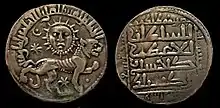Gurju Khatun
Gurju Khatun (Georgian: გურჯი-ხათუნი, Gurji-xatuni) (fl. 1237-1286) was a Georgian royal princess from Bagrationi dynasty and Queen consort of Sultanate of Rum being favorite wife of sultan Kaykhusraw II, whom she married after the death of Muhammad II of Khwarazm in 1237.[1][2] After his death in 1246 she married the Anatolian strongman Pervane. She was the mother of sultan Kayqubad II and patron to Rumi.
| Gurju Khatun | |||||
|---|---|---|---|---|---|
 Coin of Sultan Kaykhusraw II. The sun is thought to represent Gurju Khatun and the lion the sultan. (see also Lion and Sun) | |||||
| Queen consort of Sultanate of Rum | |||||
| Tenure | 1237–1246 | ||||
| Born | Tamar c.1220 Kingdom of Georgia | ||||
| Died | c.1286 (aged 65-66) | ||||
| Spouse | Kaykhusraw II Pervâne | ||||
| Issue | Kayqubad II | ||||
| |||||
| Dynasty | Bagrationi dynasty | ||||
| Father | Ghias ad-Din | ||||
| Mother | Rusudan of Georgia | ||||
| Religion | Georgian Orthodox Church, later Islam | ||||
Her title Gurju Khatun means "Georgian Lady" in Turkic languages.
She was born as Tamar (Georgian: თამარი, Tamari) and had a biblical name popular in Kingdom of Georgia and was named after her grandmother Queen Tamar the Great.[3]
Gurju Khatun was the daughter of Queen Rusudan of Georgia and the Seljuk prince Ghias ad-din, a grandson of Kilij Arslan II.
She was a sister of King David VI of Georgia.
Like most Georgians, Tamar initially remained an Eastern Orthodox Christian but is known to have converted to Islam at a later point, with no further information on how the conversion came about. It is said that the sun on the Seljuk coins of that time symbolizes Tamar, while the lion stands for the sultan himself. This emblem, known as shir-u hurshid (Lion and Sun), later became widespread in the Islamic world (though its origins date back to much earlier times). After the death of Kaykhusraw in 1246, the government of the sultanate was seized by the Pervane Mu‘in al-Din Suleyman who married Gurju Khatun.
She is known to have patronized science and art, and to have been on friendly terms with the famous Sufi poet Rumi in particular. She also sponsored the construction of the poet’s tomb in Konya.[4]
References
- Georgia and the Anatolian Turks in the 12th and 13th Centuries by A.C.S. Peacock, Anatolian Studies, Vol. 56 (2006), pp. 127-146
- Cosmopolitanism and the Middle Ages, John M. Ganim, 51
- ჯაველიძე ე., ქართული საბჭოთა ენციკლოპედია, ტ. 4, გვ. 579-580, თბ., 1979 წელი.
- H. Crane "Notes on Saldjūq Architectural Patronage in Thirteenth Century Anatolia," Journal of the Economic and Social History of the Orient, v. 36, n. 1 (1993), p. 18.
External links
| Wikimedia Commons has media related to Gürcü Hatun. |
- რატომ გააწკეპლინა გურჯი ხათუნის მეუღლემ მოლა ნასრედინი და რატომ განარისხა რუსუდან მეფე მისმა ქალიშვილმა ეკა სალაღაია, 2010-06-03
- What is behind the sun and lion figure?
- Marek, Miroslav. "An ancestry chart of her". Genealogy.EU.